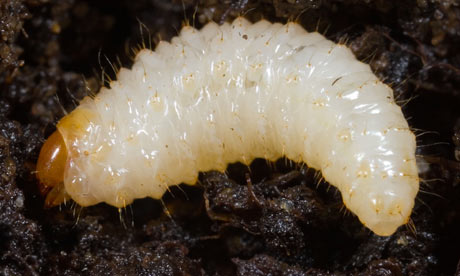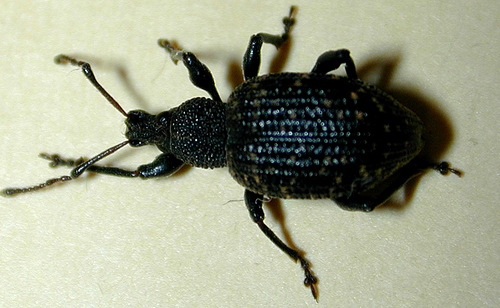Pests & diseases
General comment
If your primulas are planted in the right kind of soil, and in the right place, regular inspection will prevent most problems. Healthy, well-grown plants are less susceptible to attack by pests or disease and, in general, primulas are relatively trouble free. Nevertheless, it is necessary to be alert to the early signs of any possible problems, and to tackle them speedily if they arise. Particular care is required under glass, as problems can multiply with alarming rapidity, once they present themselves.
Vine Weevils
Probably the most important pest to look out for. The juvenile of the vine weevil is a cream comma shaped grub with a brown head about 1 cm long, which lives in the soil of your potted plant and has a particular liking for primula roots. Normally, the first sign of their presence is the collapse of a plant which was perfectly healthy until then. They must be dug out and destroyed, and infected soil must be disposed of. An infestation can spread quite rapidly.


The adult is a brown colour, - about 2 cm long and emerges in autumn. They appear like a beetle, but with the 'snout' of a weevil. If you detect irregular notches eaten out of the sides of leaves, they may be present. The adult is nocturnal, and can be trapped in rolls of corrugated paper or flowerpots stuffed with fresh grass. Such traps must be inspected every day. Gravel around the neck of plants may deter the adult from laying, and anything which confuses their sense of smell may also help. Watering pathways and areas between plants with a weak solution of disinfectant may help; some crushed mothballs scattered in the area; or perhaps sowing chives or garlic between plants. There are chemical treatments also available but we are now using a nematode programme twice a year which appears to be keeping them under control.
Root and other Aphids
Certain root aphids infest primulas planted in the open in late summer as part of their yearly cycle of regeneration. They can weaken the plants and introduce viruses. Controls include keeping the primulas weed-free, as companion weeds also act as hosts to the aphids; not allowing primulas to dry out; and not reusing old potting compost. Whitefly, greenfly and blackfly must also be contended with. Whitefly is most damaging in glasshouses, while greenfly is a common outdoor pest. Some systemic insecticides are effective, but there are also many more natural solutions such as soap sprays, sticky fly traps etc.
Slugs
Slugs can devour a tray of young seedlings and will do enormous damage to new growth in spring. Try sharp gravel, beer traps, wood ash or other appropriate slug control. Once plants are well established slugs rarely destroy them completely but do certainly make them look less attractive.
Mice
In cold spells mice will eat the crowns of plants. They will also eat developing seed pods and the fleshy roots of certain of the Asiatic primulas. Traps may be needed.
Birds
Sometimes they strip the petals from young flowers, especially the yellow varieties. They are also capable of scratching up seedlings in their search for insects. Some black cotton thread stretched over the area seems to do the trick.
Caterpillars
They cause leaf and petal damage and this will be apparent on regular inspection. Pick them off if you can see them, otherwise use an appropriate natural insecticide.
Woodlice and Millipedes
They like to live in leaf and plant debris which gathers in damp corners. Occasionally they will chew through seedlings. Best prevention is to keep your planted areas free of plant debris. They have their uses in the ecology of the garden. We are not advocating their destruction, but would encourage them to live elsewhere.
Earwigs
They live on aphids and other small fry, so in general they are beneficial. Sometimes, they nip the petals of flowers, and will also end up in paper bags with drying seed pods. When they chew their way out of the bag you may lose some of your precious seed.
Fungus
Botrytis or grey mould is the major fungal enemy of primulas. Good air circulation, and the avoidance of over watering or water- logging in cold winter conditions are very important. Keep greenhouse plants well spaced and well ventilated during the winter months and remove dead or dying leaves which may harbour fungus spores. Water very sparingly and then only from the bottom. If fungus becomes obvious, spray with a fungicide. To avoid damping off young seedlings, avoid overcrowding, overwatering and poor ventilation.
